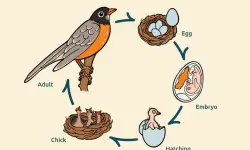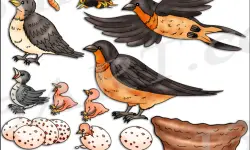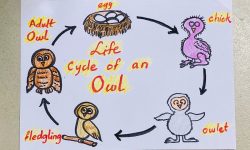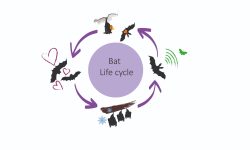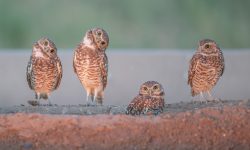The term gowk might sound unfamiliar to many, but in Scottish and Northern English dialects, it refers to the Common Cuckoo (Cuculus canorus). This bird is known for its haunting call, seasonal appearances, and mysterious behaviors. The gowk has fascinated poets, farmers, and scientists alike—not just for its arrival each spring, but for the peculiar and almost deceptive way it raises its young. This article takes you through the life of the gowk, from the moment an egg is laid to the echoing call that signals its return each year.
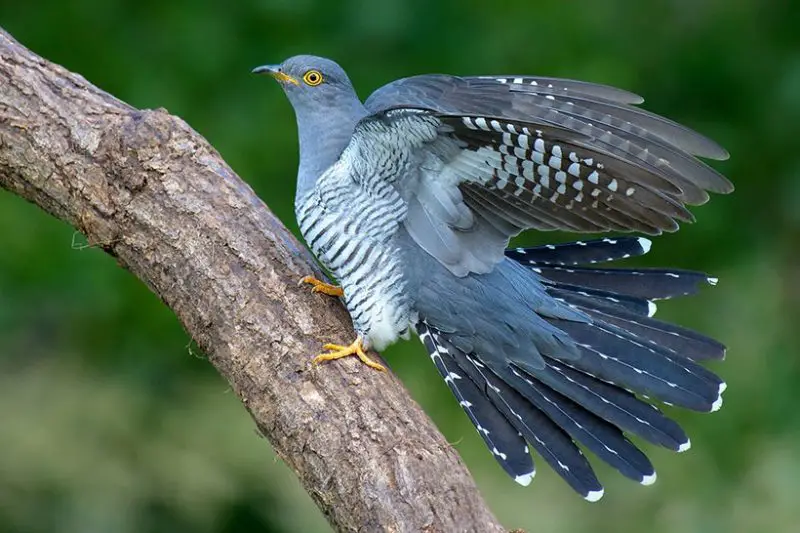
The Mating Season: A Return from the Tropics
Spring Migration to Europe and Asia
Each year in early to mid-spring—typically between late March and early May—adult Common Cuckoos (Cuculus canorus), known in Scots as gowks, undertake a long-distance migration from their non-breeding grounds in sub-Saharan Africa back to temperate regions of Europe and parts of Central and East Asia. This transcontinental journey, often exceeding 6,000 to 10,000 kilometers, is completed individually, guided not by learned behavior or parental assistance but by innate migratory programming encoded in their genes.
Cuckoos are obligate intercontinental migrants, and satellite-tracking studies have shown that they utilize multiple flyways depending on the population. British cuckoos, for instance, often pass through Iberia, Italy, or Gabon, and cross significant ecological barriers like the Sahara Desert and the Mediterranean Sea. During migration, they rely on a combination of celestial cues, geomagnetic fields, and landscape features for orientation.
Territorial Vocalizations and Courtship Dynamics
Once males arrive in their breeding territories—often open woodlands, scrub, heathlands, or reed beds—they immediately begin to establish exclusive calling territories. The male’s iconic “cuck-oo” call, produced by a pair of specialized vocal muscles not found in most other birds, plays a central role in sexual selection and territorial defense. The two-syllable phrase is structurally simple but acoustically powerful, capable of carrying over long distances in open habitats.
This vocalization has dual functions: it serves as an acoustic signal to attract receptive females and simultaneously functions as a deterrent to rival males, advertising the presence and fitness of the territory-holder. In response, females produce a bubbling or gurgling call, often while in flight, to indicate receptivity.
The mating system of the gowk is promiscuous and non-monogamous. A single male may copulate with several females throughout a breeding season. There is no pair bonding, and no parental investment from the male beyond genetic contribution. Each female, in turn, selects multiple host nests within a given territory and mates as needed to fertilize her successive eggs. Genetic studies confirm that a single female cuckoo’s clutch of eggs—though never laid in the same nest—is typically sired by more than one male.
Brood Parasitism: Nature’s Trickster at Work
The Art of Egg Laying in Another Bird’s Nest
Unlike most birds, the female gowk (Common Cuckoo) does not build a nest, incubate her eggs, or raise her young. Instead, she employs a highly evolved reproductive strategy known as obligate brood parasitism—a behavior in which she lays her eggs in the nests of other bird species, outsourcing parental care entirely.
Cuckoos are host-specific parasites, with many females specializing in a single host species. These host species are typically small insectivorous passerines, including the Meadow Pipit (Anthus pratensis), Reed Warbler (Acrocephalus scirpaceus), Dunnock (Prunella modularis), and European Robin (Erithacus rubecula). This host specialization is passed maternally through mitochondrial DNA, creating genetically distinct groups known as gentes—each adapted to mimic the egg appearance of its preferred host.
Before laying, the female cuckoo monitors potential host nests with remarkable precision, often observing from concealed perches or nearby vegetation. Timing is crucial: she typically lays her egg within 24 hours after the host has laid its own, ensuring synchrony in hatching time. During the brief laying event—usually completed in under 10 seconds—the female cuckoo often removes or consumes one of the host’s eggs to maintain clutch size and reduce suspicion.
One of the most remarkable adaptations in the cuckoo’s arsenal is egg mimicry. Each female produces eggs that closely resemble those of her host in coloration, pattern, size, and gloss. This form of coevolutionary arms race between parasite and host minimizes the chance of egg rejection. Hosts that evolve better egg recognition pressure cuckoos to evolve even more precise mimicry, leading to ongoing mutual adaptations over evolutionary time.
Laying Multiple Eggs Across the Landscape
A female cuckoo can lay up to 20–25 eggs per breeding season, typically depositing only one egg per host nest. This widespread egg distribution enhances her reproductive success while minimizing the risk of multiple eggs being discovered or rejected by any one host.
By dispersing her eggs across a broad territory, the cuckoo also reduces intra-specific competition between her own chicks, as cuckoo hatchlings are aggressive competitors and incapable of coexisting in the same nest. The absence of a parental role allows the female to invest all her energy in surveillance, mimicry, and finding optimal host nests throughout the season.
This unique strategy represents one of the most sophisticated examples of reproductive parasitism in the animal kingdom, illustrating an evolutionary balance between deception, precision, and survival.
Hatching: The Intruder Takes Over
Early Hatching Advantage
Following oviposition, the cuckoo egg undergoes accelerated embryonic development, typically hatching in just 11–12 days, which is 1–3 days earlier than the eggs of most host species. This early hatching provides a critical survival advantage by allowing the cuckoo chick to eliminate competition before the host’s own young emerge.
At hatching, the cuckoo chick is altricial—naked, blind, and completely dependent. However, it is born with a suite of innate, specialized behaviors that immediately serve its survival. Within hours, the chick begins to exhibit eviction behavior, a genetically programmed response seen across most brood-parasitic cuckoos worldwide.
Evicting the Host’s Offspring
The newly hatched gowk chick instinctively performs one of the most dramatic and ruthless acts in avian biology. Using a saddle-shaped depression on its back, along with well-developed wings and legs for its age, the chick maneuvers host eggs or nestlings onto its back, one at a time. It then heaves itself backward toward the rim of the nest and forcefully ejects the object over the edge. This process is repeated until the nest is empty of competitors.
This behavior usually occurs within 24 hours of hatching, a critical window during which the chick still has the strength to evict and before the host detects any anomalies. Once eviction is complete, the cuckoo chick remains the sole occupant of the nest and receives uninterrupted, species-inappropriate care from its foster parents.
Despite being significantly larger than its foster parents—often growing to two to three times their body mass—the chick manipulates them into feeding it by exploiting visual and auditory cues. The chick’s gaping mouth is vividly colored and unusually large, mimicking a full brood’s demand. It also produces complex, broadband begging calls that acoustically resemble multiple host chicks, triggering increased feeding rates through sensory deception.
This exploitation continues for up to three weeks post-fledging, during which the foster parents tirelessly provision the chick, unaware of the switch. The cuckoo chick, in turn, experiences rapid growth and development, fueled by this monopolized parental investment.
Rapid Growth and Fledging
Feeding and Development
Once the host nest has been monopolized, the cuckoo chick enters a phase of intense somatic growth. It receives near-constant provisioning from its foster parents, who are unaware of the identity mismatch. The chick’s begging behavior—including exaggerated gaping displays, rapid head movements, and acoustically rich begging calls—elicits a high feeding frequency.
The diet provided by the foster parents varies depending on the host species, but typically consists of insects, spiders, soft-bodied larvae, and caterpillars, including hairy and toxic species that most birds avoid. Remarkably, cuckoo chicks possess a physiological tolerance for noxious prey, particularly hairy caterpillars with urticating bristles. These are often stored in the crop, and the indigestible hairs are later regurgitated in pellet form.
By the end of the second week, the gowk chick has undergone rapid weight gain and feather development, often surpassing the adult host birds in both size and mass. This extreme growth rate is facilitated by high metabolic efficiency, coupled with uninterrupted food supply due to the lack of sibling competition. The chick develops a full set of juvenile feathers within a relatively short time span, preparing it for fledging.
Leaving the Nest
Fledging typically occurs between 18 and 24 days post-hatching, depending on the host species and environmental conditions. At this stage, the young cuckoo is fully feathered and capable of flight, although it remains dependent on its foster parents for food for several more days to a week. The fledgling may move to nearby branches or undergrowth, where it continues to vocalize and beg until provisioning ceases.
This extended post-fledging care provides a crucial period for flight muscle development, predator awareness, and energy accumulation in preparation for its upcoming migration to sub-Saharan Africa—a journey it will undertake entirely on its own. Notably, the young cuckoo receives no navigational guidance from adult cuckoos, making its solo migration a striking example of instinct-driven orientation in birds.
Autumn Migration: Guided by Instinct Alone
Flying Solo to Africa
One of the most remarkable aspects of the gowk’s life cycle is its autumn migration, particularly that of juvenile cuckoos. Unlike most migratory birds, which either follow experienced adults or migrate in flocks, the young cuckoo undertakes its first transcontinental journey entirely alone, without any parental guidance or social learning. This extraordinary feat is made possible through innate migratory programming—a genetically encoded set of navigational instructions shaped by millennia of evolutionary selection.
Shortly after fledging, in late summer to early autumn (typically August to September), juvenile cuckoos in Europe and parts of Asia begin a long-distance migration toward their non-breeding grounds in sub-Saharan Africa. This journey spans 4,000 to over 10,000 kilometers, depending on the breeding location, and requires crossing formidable geographic barriers, including the Mediterranean Sea, the Sahara Desert, and portions of the Sahel.
Advanced tracking studies using lightweight satellite transmitters have revealed that cuckoos use multiple flyways, with individuals from the same population often taking different routes. These may include a western route through Iberia and West Africa, or an eastern route through the Balkans and Central Africa. During these journeys, cuckoos navigate using a combination of geomagnetic orientation, solar cues, star patterns, and possibly even olfactory maps, although the exact mechanisms remain a topic of active scientific research.
Juvenile cuckoos complete this journey independently, without contact with their biological or foster parents—a striking demonstration of genetic memory and spatial cognition in migratory birds.
Wintering in the Tropics
Upon arrival in their African wintering grounds—ranging from the Congo Basin and Cameroon to Zambia and northern Angola—Common Cuckoos settle in open woodlands, forest edges, riparian thickets, and savannah habitats. Unlike their active, vocal presence in the breeding season, cuckoos in Africa adopt a silent and secretive lifestyle, rarely calling and often going unnoticed by observers.
Throughout the non-breeding season, which lasts from approximately October to March, cuckoos maintain a solitary existence, foraging mainly on invertebrates, particularly caterpillars—including hairy or toxic species that many insectivorous birds avoid. The cuckoo’s specialized digestive system enables it to tolerate these otherwise unpalatable prey, and the ingestion of such caterpillars may provide a key nutritional advantage during the dry season when other food sources become scarce.
During this time, cuckoos undergo feather molt, replenish energy reserves, and prepare physiologically for their return migration to the breeding grounds the following spring. Though they remain inconspicuous, their time in Africa is essential for survival, recovery, and reproductive readiness for the next stage in their migratory cycle.
Echoes of Spring: The Gowk’s Return
First Cuckoo Call of the Year
As winter loosens its grip and buds begin to bloom across the hedgerows of Britain and northern Europe, a singular, echoing “cuck-oo” heralds the change of seasons. The call of the male Common Cuckoo (Cuculus canorus)—known in Scotland as the gowk—is among the most iconic avian sounds of spring. This two-note vocalization is not merely a territorial or mating signal; it is a biological calendar, rooted in both ecological rhythms and centuries of cultural significance.
In regions such as the Scottish Highlands, Yorkshire Dales, and rural Wales, the first cuckoo call, typically heard between mid-April and early May, is met with eager anticipation. This auditory milestone has been immortalized in poetry, song, and tradition. Folkloric customs once held that the direction you faced upon hearing the first cuckoo could foretell your fortune for the year. In some tales, if coins were in your pocket when the call reached your ears, it predicted financial prosperity. Others believed it was a favorable omen for marriage or longevity, linking the bird’s return to cycles of renewal and fate.
Such beliefs reveal just how deeply the gowk’s arrival is embedded in the collective memory of rural Britain, making it not only a signal of phenological change but also a cultural touchstone passed down through generations.
Why the Gowk Matters: Ecological and Cultural Importance
A Biological Marvel
From a scientific standpoint, the gowk embodies a suite of evolutionary adaptations that continue to fascinate ornithologists. Its brood parasitic lifestyle—wherein it lays eggs in the nests of other bird species—challenges conventional models of parental investment and kin selection. Furthermore, its solo transcontinental migration, guided by inherited instinct rather than learned behavior, offers insight into the neurological and genetic basis of avian navigation.
Recent studies using geolocators and satellite tracking have shown that Common Cuckoos use individual-specific migratory routes, with little variation across years. Their ability to locate precise wintering grounds in central and southern Africa, without social guidance or prior experience, underscores the complexity of their internal compass mechanisms, involving celestial cues, geomagnetic fields, and possibly even olfactory landmarks.
These traits position the gowk as a living case study in coevolution, animal cognition, and long-distance orientation.
A Symbol in Literature and Folklore
Linguistically, the word “gowk” in Scots carries a double meaning: it refers both to the bird itself and to a “fool” or “simpleton.” This duality reflects the paradox at the heart of the cuckoo’s role in folklore. On the one hand, the cuckoo is a trickster, deceiving other species into raising its young. On the other, it is admired for this cunning—seen as clever, even prophetic. In Scottish ballads and border songs, the gowk is often invoked as a harbinger of change, a bringer of riddles, or a ghostly voice echoing through the glens.
Literary figures from Chaucer to Wordsworth have drawn on the cuckoo’s symbolism, associating it with love, betrayal, time, and transience. Its seasonal reappearance makes it a natural metaphor for the cyclicality of life and memory, and its disappearance in late summer has often been seen as a symbol of loss or fading innocence.
In both ecological systems and human imagination, the gowk is more than a bird—it is a resonant signal of change, as integral to spring as blooming hawthorn or lengthening days. Its voice bridges the natural and the mythic, the scientific and the poetic.
Conservation Concerns: A Silent Spring for the Gowk?
In recent decades, the once-familiar springtime voice of the Common Cuckoo (Cuculus canorus)—or gowk—has grown noticeably quieter across parts of Europe. Nowhere is this decline more pronounced than in the United Kingdom, where populations have plummeted by over 65% since the 1980s. This troubling trend has raised urgent questions among ornithologists, conservationists, and bird lovers alike: what is silencing the gowk?
A Cascade of Environmental Pressures
The cuckoo’s complex life cycle makes it particularly vulnerable to ecological imbalance. Its survival depends not only on the health of its own habitat but also on that of its host species—small passerines like Meadow Pipits, Reed Warblers, and Dunnocks. As these host populations decline due to habitat fragmentation, urban expansion, and agricultural intensification, so too do the breeding opportunities for the cuckoo.
Perhaps even more critical is the decline in insect abundance, particularly caterpillars, which form the staple diet of cuckoo chicks and the host birds’ own young. The widespread use of neonicotinoid pesticides and other agrochemicals has decimated insect populations across Europe, depriving birds of essential food sources at crucial times in their breeding cycle.
The Climate Change Conundrum
Climate change introduces a more insidious and far-reaching threat: phenological mismatch. As spring temperatures rise earlier in the year, many host species begin nesting sooner. However, cuckoos migrating from Africa may not adjust their arrival times accordingly, leading to missed nesting windows. If the host species have already laid and begun incubation, the female cuckoo cannot exploit the nest—leading to reproductive failure.
This temporal disjunction underscores the fragility of the cuckoo’s reproductive strategy, which relies on precise timing within both the European breeding season and the African wintering cycle.
Tracking the Gowk’s Journey
In response to these declines, ornithological research has intensified. Projects such as the British Trust for Ornithology’s Cuckoo Tracking Initiative have fitted birds with satellite tags to follow their migration from the UK to central and southern Africa. These studies have revealed that many cuckoos follow distinct migratory flyways, including routes over Spain and Italy or via the Balkans. The data help identify critical stopover sites and habitats, both in Europe and Africa, that are essential to the species’ survival.
Conservationists are now focusing on cross-continental solutions that integrate habitat protection, insect recovery efforts, and sustainable land management. Understanding the gowk’s full life cycle—from parasitic egg to African winterer—is key to reversing the decline of this enigmatic bird.
Conclusion: A Life Shaped by Deception and Distance
The life of the gowk—from egg to echo—is shaped by cunning, timing, and endurance. It deceives its way into a foster nest, grows by stealing attention, then crosses continents to begin the cycle again. Whether seen as a trickster or a traveler, the gowk remains one of nature’s most enigmatic and fascinating birds.

